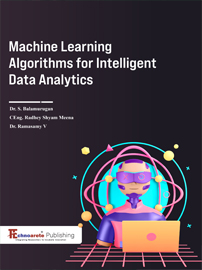Integrating Smart Wearables and Exploratory Data Analysis for Disease Prediction
S. Menaga
Associate Professor, Department of Computer Science and Engineering, Hindusthan College of Engineering and Technology.
Corresponding Author:dsatheeshme@gmail.com
Dr.G.Kalaiarasi
Associate Professor, Department of Electronics and Communication Engineering, VSB Engineering College, Karur, India
Corresponding Author:kalaiibe@gmail.com
Dr. R.Vanithamani
Professor, Department of Biomedical Instrumentation Engineering, School of Engineering, Avinashilingam Institute for Home science and Higher Education for Women, India
Corresponding Author:vanithamani_bmie@avinuty.ac.in
M.Nivetha
Assistant Professor, Department of Electronics and Communication Engineering, Jai Shriram Engineering College, Tiruppur, India
Corresponding Author:niveathaece@gmail.com
Abirami A
Department of Computer Science and Engineering, Bannari Amman Institute of Technology, Alathukombai, Sathyamangalam, Erode, Tamilnadu, India
Corresponding Author:abirarmia@bitsathy.ac.in
Lakshmanaprakash S
Department of Computer Science and Engineering, Bannari Amman Institute of Technology, Alathukombai, Sathyamangalam, Erode, Tamilnadu, India
Corresponding Author:lakshmanaprakashs@bitsathy.ac.in
Abstract :
In today’s modern world with a population of more than 7.5 billion people, the advancement in predicting and diagnosing patients has become preeminent. The most common problem doctors face across the globe in treating the patient is identifying the disease at the eleventh hour or even later. This is not the sole problem of the patients themselves. At the time when the patient consults with the doctor for the disease, mostly it will be untreatable or will be treated just to get side effects post treatment. In the 21st century, while treatment has been modernized and a cure for thousands of diseases has been found compared to the past 4-5 decades, still Coronary Artery Disease (CAD) tolls nearly 15.5% of annual deaths which is nearly 8.8 Million in 2015. This rate is said to be increased quarterly by now. However untreated CAD or treating CAD in the annihilate stage ends up in chest pain, and arrhythmia and even becomes fatal with heart failure
[1]. However, this ratio can be changed to a nominal level if the symptoms or the disease are identified at an earlier stage. In this chapter, we will discuss one of the effective methods for identifying Cardiovascular Diseases at an earlier stage using smart wearables and other non-invasive products. Smart wearables from smartwatches to smart suits and other medical products like non-invasive medical patches will be discussed on how the data collected from these devices helps in predicting CAD after performing exploratory data analysis on the collected dataset. This area of research is currently limited to predicting cardiovascular diseases as only the dataset for CAD is been found with the most accurate data which is easier to discover patterns, spot anomalies, test hypotheses, and check assumptions with the help of summary statistics and graphical representations.
Keywords:
- Smart Wearables,
- Disease Prediction,
- Exploratory Data Analysis,
- Cardiovascular Disease,
- User interface design,
- Coronary Artery Disease
Reference
[1]. Kavakiotis I, Tsave O, Salifoglou A, Maglaveras N, Vlahavas I, Chouvarda I. Machine learning, and data mining methods in diabetes research. Computational and structural biotechnology journal. 2017; 104-116.
[2]. Y. Liu, H. Wang, W. Zhao, M. Zhang, H. Qin, and Y. Xie, “Flexible, stretchable sensors for wearable health monitoring: sensing mechanisms, materials, fabrication strategies and features,” Sensors, vol. 18, no. 2, p. 645,
[3]. T. Arakawa, “Recent research and developing trends of wearable sensors for detecting blood pressure,” Sensors, vol. 18, no. 9, p. 2772, 2018.
[5]. X. Li, J. Dunn, D. Salins et al., “Digital Health: tracking physiomes and activity using wearable biosensors reveals useful health-related information,” PLoS Biology, vol. 15, no. 1, Article ID e2001402, 2017.
[6]. Patil PH, Thube S, Ratnaparkhi B, Rajeswari K. Analysis of Different Data Mining Tools using Classification, Clustering and Association Rule Mining. International Journal of Computer Applications. 2014; 93(8):35-39.
[7]. American Heart Association. Cardiovascular diseases affect nearly half of American adults, statistics show. (https://www.heart.org/en/news/2019/01/31/cardiovascular-diseases-affect-nearly-half-of-american-adults-statistics-show) Accessed 9/28/2021.
[8]. Centers for Disease Control and Prevention. Heart Disease. (https://www.cdc.gov/heartdisease/about.htm) Accessed 9/28/2021.
[9]. Centers for Disease Control and Prevention. Heart Disease Facts. (https://www.cdc.gov/heartdisease/facts.htm) Accessed 9/28/2021.
[10]. World Health Organization. Cardiovascular diseases (CVDs). (https://www.who.int/news-room/fact-sheets/detail/cardiovascular-diseases-(cvds%29) Accessed 9/28/2021.
[11]. ACC/AHA Clinical Practice Guideline. 2019 ACC/AHA Guideline on the Primary Prevention of Cardiovascular Disease: A Report of the American College of Cardiology/American Heart Association Task Force on Clinical Practice Guidelines. (https://www.ahajournals.org/doi/pdf/10.1161/CIR.0000000000000678) Accessed 9/28/2021.
[12]. Tsao CW, et al. Heart Disease and Stroke Statistics—2020 Update: A Report From the American Heart Association. Circulation 2020. (https://www.ahajournals.org/doi/pdf/10.1161/CIR.0000000000000757) Accessed 9/28/2021.
[13]. Cho L, Davis M, Elgendy I, et al. Summary of Updated Recommendations for Primary Prevention of Cardiovascular Disease in Women JACC State-of-the-Art Review. (https://www.jacc.org/doi/abs/10.1016/j.jacc.2020.03.060) J Am Coll Cardiol 2020 May, 75(20):2602-2618. Accessed 9/28/2021.
[14]. Exploratory Data Analysis on Heart Disease UCI data set - A complete step-by-step exploratory data analysis with a simple explanation by Aishah Ismail
[15]. Chan M., Esteve D., Fourniols J.Y., Escriba C., Campo E. Smart wearable systems: Current status and future challenges. Artif. Intell. Med. 2012;56:137–156
[16]. Patel S., Park H., Bonato P., Chan L., Rodgers M. A review of wearable sensors and systems with application in rehabilitation. J. Neuroeng. Rehabil. 2012;9:1–17.
[17]. Khan Y., Ostfeld A.E., Lochner C.M., Pierre A., Arias A.C. Monitoring of vital signs with flexible and wearable medical devices. Adv. Mater. 2016;28:4373–4395. doi: 10.1002/adma.201504366.
[18]. Hwang I., Kim H.N., Seon G.M., Lee S.H., Kang M., Yi H., Bae W.G., Kwak M.K., Jeong H.E. Multifunctional smart skin adhesive patches for advanced health care. Adv. Healthc. Mater. 2018;7:1800275. doi: 10.1002/adhm.201800275.
[19]. Kamisalic A., Fister I., Jr., Turkanovic M., Karakatic S. Sensors and functionalities of non-invasive wrist-wearable devices: A review. Sensors. 2018;18:1714. doi: 10.3390/s18061714.

